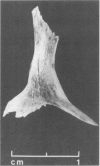Abstract
A prospective study was performed on 358 patients to examine the diagnosis, management, and natural history of fish bone ingestion. All patients admitted with the complaint had a thorough oral examination. Flexible endoscopy under local pharyngeal anesthesia would be performed on patients with negative findings. Of 117 fish bones encountered, 103 were removed (direct removal, 21; endoscopic removal, 82) and 12 were inadvertently dislodged. One was missed and the other one necessitated removal with rigid laryngoesophagoscopy under general anesthesia. Morbidity (1%) occurred in patients with triangular bones in the hypopharynx, resulting in one mucosal tear and two lengthy procedures. Mean hospital stay was 7 hours. Prediction of the presence of fish bones by symptoms and radiograph was poor. The location of symptoms, however, was useful in guiding the endoscopist to the site of lodgment. Of patients who refused endoscopy, only one (2.8%) developed retropharyngeal abscess. As compared to those who received endoscopy, 31.8% had fish bones detected. As the yield of fish bone detected was also inversely related to the duration of symptoms, we strongly suspect that most of the unremoved fish bones would be dislodged and passed. However, because of the serious potential complication from fish bone ingestion, we believe that a combination of oral examination followed by flexible endoscopy is indicated in all patients. When triangular bones in the hypopharynx are encountered, rigid laryngoesophagoscopy should be considered. This protocol had safely and effectively dealt with the present series of patients.
Full text
PDF



Images in this article
Selected References
These references are in PubMed. This may not be the complete list of references from this article.
- BARRETT J. H. Foreign bodies in the air and food passages; observations in one hundred eight private patients. AMA Arch Otolaryngol. 1951 Dec;54(6):651–665. doi: 10.1001/archotol.1951.03750120044007. [DOI] [PubMed] [Google Scholar]
- GOLDMAN J. L. Fish bones in the esophagus. Ann Otol Rhinol Laryngol. 1951 Dec;60(4):957–973. doi: 10.1177/000348945106000405. [DOI] [PubMed] [Google Scholar]
- Nandi P., Ong G. B. Foreign body in the oesophagus: review of 2394 cases. Br J Surg. 1978 Jan;65(1):5–9. doi: 10.1002/bjs.1800650103. [DOI] [PubMed] [Google Scholar]
- Selivanov V., Sheldon G. F., Cello J. P., Crass R. A. Management of foreign body ingestion. Ann Surg. 1984 Feb;199(2):187–191. doi: 10.1097/00000658-198402000-00010. [DOI] [PMC free article] [PubMed] [Google Scholar]



